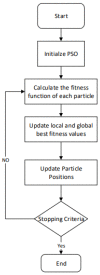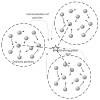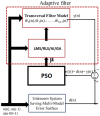Adaptive Filtering: Issues, Challenges, and Best-Fit Solutions Using Particle Swarm Optimization Variants
- PMID: 37765768
- PMCID: PMC10537715
- DOI: 10.3390/s23187710
Adaptive Filtering: Issues, Challenges, and Best-Fit Solutions Using Particle Swarm Optimization Variants
Abstract
Adaptive equalization is crucial in mitigating distortions and compensating for frequency response variations in communication systems. It aims to enhance signal quality by adjusting the characteristics of the received signal. Particle swarm optimization (PSO) algorithms have shown promise in optimizing the tap weights of the equalizer. However, there is a need to enhance the optimization capabilities of PSO further to improve the equalization performance. This paper provides a comprehensive study of the issues and challenges of adaptive filtering by comparing different variants of PSO and analyzing the performance by combining PSO with other optimization algorithms to achieve better convergence, accuracy, and adaptability. Traditional PSO algorithms often suffer from high computational complexity and slow convergence rates, limiting their effectiveness in solving complex optimization problems. To address these limitations, this paper proposes a set of techniques aimed at reducing the complexity and accelerating the convergence of PSO.
Keywords: adaptive filtering; bit error rate; particle swarm optimization; signal quality.
Conflict of interest statement
The authors declare no conflict of interest. The funders had no role in the design of the study; in the collection, analyses, or interpretation of data; in the writing of the manuscript; or in the decision to publish the results.
Figures







References
-
- Kennedy J., Eberhart R. Particle swarm optimization; Proceedings of the ICNN’95-International Conference on Neural Networks; Perth, WA, Australia. 27 November–1 December 1995; pp. 1942–1948.
-
- Djaneye-Boundjou O.S.E. Doctoral’s Dissertation. University of Dayton; Dayton, OH, USA: 2013. Particle Swarm Optimization Stability Analysis.
-
- Shi Y. Particle swarm optimization. IEEE Connect. 2004;2:8–13.
-
- Minasian A.A., Bird T.S. Particle swarm optimization of microstrip antennas for wireless communication systems. IEEE Trans. Antennas Propag. 2013;61:6214–6217. doi: 10.1109/TAP.2013.2281517. - DOI
-
- Banks A., Vincent J., Anyakoha C. A review of particle swarm optimization. Part I: Background and development. Nat. Comput. 2007;6:467–484. doi: 10.1007/s11047-007-9049-5. - DOI
Publication types
Grants and funding
LinkOut - more resources
Full Text Sources
Medical
Miscellaneous

